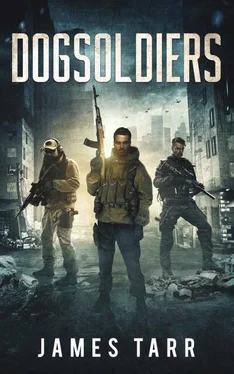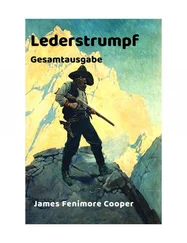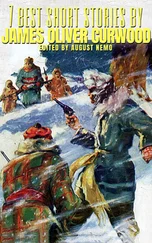Noise was more of a factor than speed in the woods and they picked their way carefully around patches of dried leaves and over crumbling deadfalls. The farther they got from the crash site the more important noise discipline became.
The original plan had been to roll south on the Pres until just before the city border, then hide the Ford inside one of the numerous abandoned commercial buildings nearby and continue on foot. The Tabs, however, now knew they were in the area. Ed had no way of knowing if the helicopter pilot had had time to radio their troop strength before Arnold shot him down, but the search and rescue teams would, for their own safety, have to assume there were still a few guerrillas in the area. The Army would either expect them to continue south on their mission, if they had one, or retreat back north, but they’d check at least half a mile in every direction just to be thorough. How much they did beyond that would be an indication of how well informed they were about survivors.
The squad moved west through the trees for several hundred yards until more houses came into view. They could still hear the Kestrel circling in the distance, and Ed thought he heard the faint growl of diesel engines as well. Army vehicles.
They reached the street bordering the far side of the woods and spread out in a line. Every man in the squad studied the row of houses on the far side of the concrete ribbon, watching and listening. These were compact houses, little more than cubes of red brick with bumpy roofs and small, detached garages, half of which were falling down. But there were many mature trees lining the streets, which was good. Ed really wanted to move farther south through the woods, but the sound of diesel engines was louder in that direction and they had to get out of the trees quickly, while they had the chance, before the Kestrel pilot got tired of circling over the wreckage. The trees made for excellent cover, but the other side knew that as well.
Ed pointed at Quentin and Weasel and together the three of them sprinted across the street and did a quick check of the nearby yards. The men didn’t find anybody hiding in the bushes, and so he signaled to the rest of the squad. They came running across in pairs without incident, then the squad cut through the fence-enclosed backyards to the next street, then dashed across that. Then they started heading directly west through the backyards between two parallel east-west streets.
The ever-present chain-link fences made for slow, arduous going, but they didn’t dare travel down sidewalks or streets. The Kestrel swung over them twice, but each time they had plenty of warning. Half the houses were vacant, with yawning doors and windows indicating that at some point in the past they’d been looted, but the men didn’t like diving inside buildings they hadn’t checked out first unless actually under fire. However, the back yards were so small they were never more than a dozen feet from a ragged patio awning, or some overgrown ornamental tree they could hide under. When the temperature got over eighty they’d learned the Kestrel’s thermal imager was undependable if they were under roofs, so as long as they couldn’t be seen with the naked eye they should be okay. Should be.
The four two-man sniper teams had flown in on one of the regular weekly supply planes, then ridden in buttoned-up IMPs to the base downtown. They’d already spent some time looking over maps of the area, and once they arrived they all took at least one overflight of the city in a rotary wing to get a proper look at the place. It was even more of a shithole than they’d been told, but still it seemed to be full of people, and they should have a lot to do. It helped that the rules of engagement were simple.
They weren’t regular Army incompetents, they were Special Forces, so they did things a little differently. They wouldn’t be supporting regular Army patrols, no matter how much the full bird colonel in charge of the base would have preferred, and had in fact demanded of their unit commander, to no avail. Instead, they stripped off their camouflage fatigues for civilian clothes, to better blend in, and then moved out of the base into the city on foot, in the middle of the night, using their NODs. Intelligence said the guerrillas in the city didn’t have much night vision capability, so they thought their best bet was to move around at night and then be in position by dawn.
Every team had a different sector of the city, and the plan was to be out beyond the wire for three days. They had enough water and food for four, just in case.
Keeley and Hulce were Anvil-6, and had chosen their first hide well. They were set up in the second floor of a small office building on the northeast corner of a major intersection about six miles north-northwest of the military base. It had taken them all night to hike in, but being able to see in the dark made things much easier. They saw a number of people, unarmed locals, who never saw or heard them passing, and a surprising amount of wildlife, dogs and possums and a raccoon, all of which had no problem seeing the men in the dark.
Through the fractured windows they could see south along Meyers for a third of a mile, and through the ragged gap in the bricks of the west wall they could see west on McNichols for three-quarters of a mile. Hulce was prone atop a desk six feet back from the windows, positioned so his bullet would pass between two angular pieces of pane somehow still stuck in the frame. The men had actually pushed two desks together, and if he needed to Hulce could rotate behind the rifle and look west through the foot-wide hole in the bricks.
Both of the men were sniper trained, but this mission Keeley was tasked with support, and Hulce was the designated sniper. He was toting a suppressed bolt-action .300 WinMag, and Keeley had a sound-suppressed M5 to back him up and provide site security, as well as be the eye on the spotting scope. Hulce also had a suppressed PDW in his pack for close-range defense, if the need arose, but it would take him some time to get to it.
As the sun rose on the city they began to see movement, but no guerrilla activity. A few people walking here and there, but none of them were armed or wearing armor. Keeley diagrammed the site in his logbook and used the laser rangefinder to get the exact distance to several landmarks both south and west of their location. They worked out the drop of his rounds at that distance and Hulce made notes on the sheet of paper in front of himself. This way he’d be able to dial in the drop and get on target more quickly.
Keeley had both 8X binoculars and a 30X spotting scope set up on a tripod. The binoculars didn’t have nearly the same magnification, but they had a much greater field of view. He glassed the area with the binos, and if he saw something that warranted further investigation he went to the spotting scope. Hulce stayed on the variable power riflescope, and at 10X he had a good balance between magnification and field of view.
After they’d been in position close to an hour, switching vantage points a few times, they decided Keeley should take the southward eye, as there was a wide sixty-degree field of view out the front window, something better tackled with binos. Keeley would stay on the rifle pointed west down McNichols through the hole in the bricks. Three hours after dawn they still hadn’t seen any guerrilla activity, but there was much more movement on the street. At any one time Hulce could see a half a dozen people on foot. They weren’t guerrillas, just local residents, although they more closely resembled starving or crazy refugees.
Hulce’s eye was drawn to some activity on the left side of the street. It was on the far side of the service drive to the expressway which angled southeast toward downtown. Two men were arguing in front of a low brick building. There was a shopping cart between them laden with junk and that seemed to be the subject of debate, but the sniper had no idea which of the men the cart belonged to.
Читать дальше












